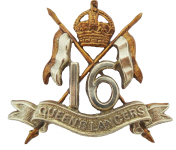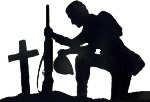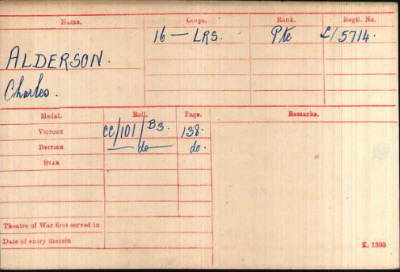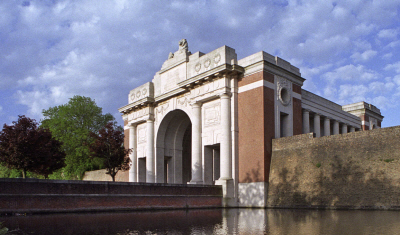




Aged 23

No. 5714, Private, 16th (The Queen's) Lancers
Killed in Action on Sunday, 21st February 1915
|
Born in Q2-1891 [Darlington 10a:6] in St John's, Darlington, Co.Durham,to Thomas and Margaret ALDERSON(née WOODEND) of 3 Dickinson
Street, Bank Top, Darlington. 1901 census...At 3 Dickinson Street, Darlington were Charles [10] with his father Thomas [35] a machinist at iron works, born Darlington; his mother Margaret [35] born Darlington and his brother John W [12] and sister Ida [7] both born in Darlington. 1911 census...Charles [20] was in Newmarket, a stableman with Martin Gurry at Abington Place, Bury Road. The rest of his family and a cousin Herbert PELLOWS [22] were still at the same house in Darlington. 3 siblings had been born and since died. Also at Abington Place was another casualty from this record, Charles Friedlander who is buried in Newmarket. His parent later moved to 76, Beaconsfield St., Greenbank, Darlington, Co. Durham. The pension card put them first at 3 Dickinson St., Darlington, and after his mother died, father was at 22 Tennyson Gardens, Darlington. For some reason his entry on the Memorial only had his initial rather than his given name, this was corrected in 2008. Although his medal index card only shows the War Medal and the Victory Medal it is self evident that he qualified for the 1914-15 Star since he was killed in Belgium in 1915 He was killed in the same action as Lieutenant Nathaniel KING see here |

|
The 21st was an unusually disastrous day for the Regiment. The 16th Lancers were holding the line north of Klein Zillebeke on the edge of
Shrewsbury Forest. The enemy's trenches ran parallel to those of the 16th at a distance varying from 15 to 50 yards only. In front of the
right of D Squadron was a deep ditch which ran from the German trench to that occupied by the Squadron. It had been suspected for some days
that the enemy was running a sap at the bottom of this ditch, and a close observation had been kept on it, but no sign of anything of the
sort had been discovered. It turned out afterwards that the enemy had really run a sap half way down it, but had turned off at a sharp
angle and continued the sap underground until it ran under the centre of the trench of D Squadron, and that three mines had been placed at
the end of it. It was afterwards ascertained from prisoners that the mines had been laid some days before the 16th took over the trench,
but that the explosion had been delayed with the intention of catching the relief when they were taking over on the 18th, but the
opportunity had fortunately been missed. At 6 a.m. on the 21st one mine was fired, followed immediately afterwards by the other two, with the result that the trench was completely destroyed. The enemy followed this up with a strong attack on the trenches on each side of that held by D Squadron. There was of course much confusion and a hand to hand combat, in which the enemy was finally driven back by A Squadron and the reserve troop of D with a machine gun. A counter-attack was made by the three reserve troops. They were unable to regain the lost trench, and a request for help was sent to two companies of French Infantry which were in support of the left section of the trench, but these refused to move without orders from their own commanding officer A counter attack was not made until 9 a.m., when the line was reinforced by a squadron of the 20th Hussars and another Company of French infantry from the supporting line. The French were stopped at once by the heavy fire they were met with, all their officers and half their men being shot down in a few minutes. The 2Oth got a little further when they were brought up by an enfilade fire and the attack was broken off. No further attempt was made to regain the lost trench, but a new one was dug in rear of it. This was the worst day the 16th had during the whole of the war. When the roll was called it was found that 5 officers and 7 men were killed, an officer and 29 men wounded. In addition 1 officer and 11 men were missing. |


photo: Commonwealth War Graves Commission
click here to go to the Commonwealth War Graves Commission website for full cemetery/memorial details